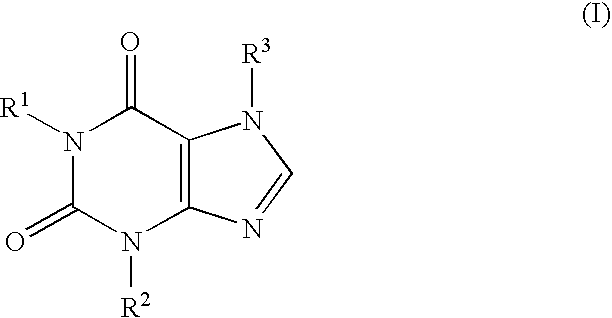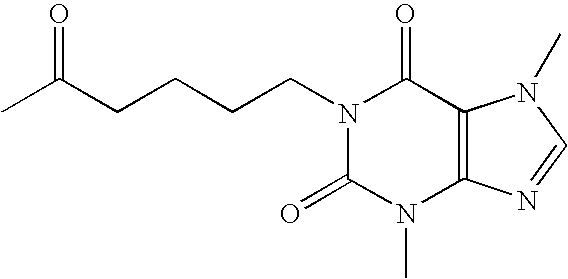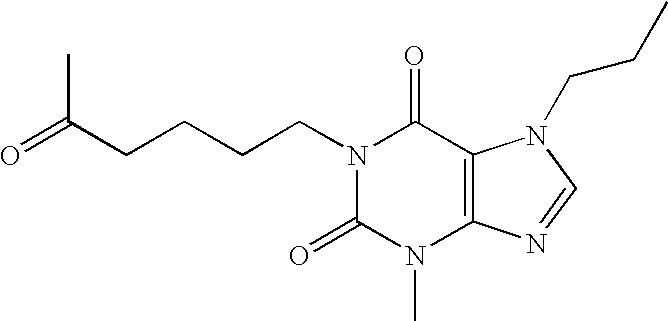Methods and compositions for the treatment of vascular depression
a technology of vascular depression and compositions, applied in the direction of drug compositions, biocide, cardiovascular disorders, etc., can solve the problems of poorer long-term antidepressant treatment outcomes and association with the progression of subcortical ischemic diseas
- Summary
- Abstract
- Description
- Claims
- Application Information
AI Technical Summary
Benefits of technology
Problems solved by technology
Method used
Image
Examples
example 1
Pentoxifylline and Propentofylline Treatment of Vascular Depression
[0126] These case studies investigate the effects of pentoxifylline and propentofylline in one or more elderly patients (>60 years of age) with a diagnosis of vascular depression (assessed by Alexopolis criteria or MRI as described elsewhere herein, or for elderly patients who had previously failed to respond to standard antidepressant therapy). Patients are evaluated at baseline and at regular intervals for a period of months. They are evaluated according to the Hamilton Depressive Rating Scale (HDRS; Hamilton, J. Neurol. Neurosurg. Psychiatry 23:56-62 (1960)). Patients are excluded if their HDRS is ≦15.
[0127] In one group, pentoxifylline is administered orally in a dose of 400 mg three times a day. In another group, propentofylline is administered orally in a dose of 200 mg three times a day.
[0128] Results: HDRS scores are expected to decrease after several months in subjects receiving either pentoxifylline or p...
example 2
Combination Treatment of Vascular Depression With SSRIs or SNRIs
[0129] These case studies investigate the effects of a combination treatment of pentoxifylline or propentofylline in combination with an SSRI or SNRI in one or more elderly patients with a diagnosis of vascular depression. Methods for the assessment of patients and for the administration of pentoxifylline or propentofylline are as described in Example 1. However, in addition to pentoxifylline or propentofylline, subjects are also administered escitalopram, citalopram, or venlafaxine. Escitalopram is administered orally in a dose of 10 mg once daily. Citalopram is administered orally in a dose of 20 mg once daily initially for one week and increasing to 40 mg once a day thereafter.
[0130] The individuals are monitored for a period of months and evaluated as described in Example 1.
[0131] Results: HDRS scores are expected to decrease after several months in subjects receiving either pentoxifylline or propentofylline in c...
example 3
Pentoxifylline and Propentofylline Add-On Treatment of Vascular Depression
[0132] These case studies investigate the effects of pentoxifylline and propentofylline in one or more elderly patients (>60 years of age) with a diagnosis of vascular depression and who are currently being treated with an SSRI and / or SNRI.
[0133] Patients are evaluated at baseline and at regular intervals for a period of months. They are evaluated according to the Hamilton Depressive Rating Scale (HDRS; Hamilton, J. Neurol. Neurosurg. Psychiatry 23:56-62 (1960)).
[0134] In one group, pentoxifylline is administered orally in a dose of 400 mg three times a day to augment their SSRI and / or SNRI treatment regimen. In another group, propentofylline is administered orally in a dose of 200 mg three times a day to augment their SSRI and / or SNRI treatment regimen.
[0135] Results: HDRS scores are expected to decrease after several months in subjects receiving either pentoxifylline or propentofylline in addition to the...
PUM
| Property | Measurement | Unit |
|---|---|---|
| weight | aaaaa | aaaaa |
| body weight | aaaaa | aaaaa |
| body weight | aaaaa | aaaaa |
Abstract
Description
Claims
Application Information
 Login to View More
Login to View More - R&D
- Intellectual Property
- Life Sciences
- Materials
- Tech Scout
- Unparalleled Data Quality
- Higher Quality Content
- 60% Fewer Hallucinations
Browse by: Latest US Patents, China's latest patents, Technical Efficacy Thesaurus, Application Domain, Technology Topic, Popular Technical Reports.
© 2025 PatSnap. All rights reserved.Legal|Privacy policy|Modern Slavery Act Transparency Statement|Sitemap|About US| Contact US: help@patsnap.com



